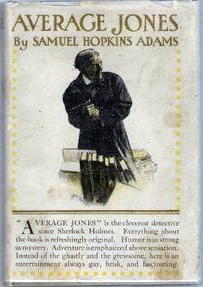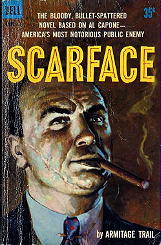SAMUEL HOPKINS ADAMS – Average Jones.
Bobbs-Merrill, hardcover, 1911. Story collection.
As an assiduous reader of personal advertisements — and if you won’t admit to doing the same, I think you’ll agree they are important plot points in a number of detective novels – I warmed instantly to Adrian Van Reypen Egerton Jones, nicknamed Average Jones for obvious reasons.
A highly intelligent, very rich, and terribly bored young man, as the first yarn opens he is wondering what to do with himself. His friend Mr Waldemar, owner of The Universal, an important New York City paper, suggests Jones set up as a kind of one man consumer protection wallah, giving advice, as Jones’s business card will later declare, “upon all matters connected with Advertising.” As a bonus, Jones will pass on discoveries about various swindles perpetrated through ads to Waldemar, thus keeping the paper’s lengthy advertising columns “clean.”

Jones gives it a whirl and soon becomes engrossed in the work to the extent of setting up an agency to handle the more humdrum requests for advice while he looks into ads that grab his attention, particularly those hinting at criminal activity. Average Jones relates the cases he investigates.
“The B-Flat Trombone” is a locked room mystery. By what method was mayoral candidate William Linder blown up in a locked room on the third floor of his mansion on Kennard Street in Brooklyn?
After three unsuccessful attempts on his life, Malcolm Dorr keeps two guard dogs. Both are killed yet neither were shot or poisoned. Then there is a rash of canine deaths in Bridgeport, Connecticut. Is there any connection between these events and the mysterious “Red Dot”?
Where is young rakehell Roderick Hoff? His father engages Jones to find him. Jones follows an “Open Trail” to do so and then outfoxes Hoff’s swindling father when he tries to wiggle out of paying the reward money.
“Mercy Sign” is a dark story rooted in a real historical tragedy. Jones and his friend Robert Bertram look into a strange affair involving a missing academic assistant, a wrecked houseboat, and a dead foreign dignitary.
Jewels nicknamed the “Blue Fires” form a beautiful necklace, a gift from Mr Kirby to his fiancee Edna Hale. Their disappearance means their wedding is postponed. What do a torn curtain and broken-off bed knob have to do with the matter?
Anonymous letters of a particularly nasty sort are written out in “Pin-Pricks” on junk advertising mail sent to William Robinson. What is the purpose of these communications and who could be responsible?
Bailey, the son of rural minister Rev’d Peter Prentice, is missing after a meteor lands on a New England barn and sets it alight. An ad appears revealing he is alive but not where, but a certain bit of “Big Print” aids Jones in tracing the lost boy.
Enderby Livius is “The Man Who Spoke Latin,” claiming he cannot speak English. Livius is up to no good in bibliophile Colonel Ridgway Graeme’s chaotic library, and to find out what it is Jones poses as a mute classical scholar.
“The One Best Bet” begins with a man committing suicide because he arrives too late to amend his personal ad, having had second thoughts about its content – as well he might, since it reveals a plot to murder the governor. Can the crime be prevented?
“The Million-Dollar Dog” involves one of those odd wills beloved by the rich in detective fiction. Judge Hawley Ackroyd’s advertisement seeking l0,000 black beetles puts Jones on the trail of an attempt to gain a fortune by underhanded means.
My verdict: What an inventive way to introduce a detective to cases in all levels of society! I enjoyed this collection a great deal and recommend it to readers who like slightly offbeat and very clever stories. Now I’m off to read the personal ads in today’s papers….
Etext: www.gutenberg.org/dirs/etext04/vrjns10.txt
Besides being a novelist with several works of mystery and detective fiction to his credit, Samuel Hopkins Adams was also a well-known “muckraker” and investigative reporter. For more information on his life and career, a good place to start looking would be his Wikipedia entry.
From Crime Fiction IV, by Allen J. Hubin:
ADAMS, SAMUEL HOPKINS (1871-1958); see pseudonym Warner Fabian.
* Average Jones (Bobbs, 1911, hc) [Average Jones] Palmer, 1911.
* The Flying Death (McClure, 1908, hc) [Long Island, NY]
* _The Mystery (with Stewart Edward White) See entry under Stewart Edward White.
* _The President’s Mystery Story [as by Franklin D. Roosevelt] See entry under Franklin D. Roosevelt
* The Secret of Lonesome Cove (Bobbs, 1912, hc) [New England] Hodder, 1913.
FABIAN, WARNER; pseudonym of Samuel Hopkins Adams.
* -The Men in Her Life (Sears, 1930, hc) Film: Columbia, 1931 (scw: Robert Riskin, Dorothy Howell; dir: William Beaudine).
WHITE, STEWART EDWARD
* The Mystery (with Samuel Hopkins Adams) (McClure, 1907, hc) [Percy Darrow; Ship] Hodder, 1907.
ROOSEVELT, FRANKLIN
* The President’s Mystery Story [by Anthony Abbot, Samuel Hopkins Adams, John Erskine, Rupert Hughes, S. S. Van Dine & Rita Weiman] (Farrar, 1935, hc) Lane, 1936. Revised edition: Prentice-Hall, 1967, as The President’s Murder Plot. A mystery novel suggested by Roosevelt and written, a chapter each, by seven mystery writers. Film: Republic, 1936, as The President’s Mystery; also released as One for All (scw: Lester Cole, Nathaniel West; dir: Phil Rosen).
